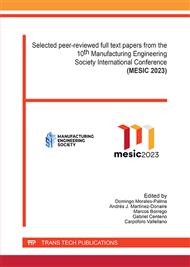p.109
p.120
p.129
p.140
p.147
p.155
p.167
p.176
p.184
Using PETG/rPET Blends in Fused Particle Fabrication: Analysis of Feasibility and Mechanical Behaviour
Abstract:
Additive Manufacturing (AM) production of plastic parts has experienced a continuous increase during the past decades. Simultaneously, advanced societies have become deeply concerned about the use of plastics and their impact on natural environments. As a result, there is a growing interest in recycled plastic as a feedstock material in additive manufacturing machines. However, the commercialization of recycled plastic filament introduces additional production and distribution steps. An alternative approach would avoid these steps by mixing recycled particles (obtained from local waste) with brand-new particles and using the resultant blend with Fused Particle Fabrication (FPF) machines, but some alimentary plastics, like Polyethylene Terephthalate (PET) have printability issues that hamper their direct use in AM. Present work analyses the feasibility of extruding blends composed of Polyethylene Terephthalate Glycol (PETG) spherical pellets and recycled Polyethylene Terephthalate (rPET) flakes so that local prosumers could give a second use to their own wasted water bottles. Additionally, tensile, and flexural specimens were analyzed for combinations of different rPET particle sizes and PETG/rPET blends (100%PETG, 30%rPET/70%PETG, 50%rPET/50%PETG, and 70%rPET/30%PETG). The experimental program included relaxation tests from which the relaxation modulus, E(t), was obtained. The results showed that the addition of PETG combined with a modification that insufflates pressurized air into the pellets inlet would permit to print blends up to a 70% rPET. It has also been found that an increase in the percentage of rPET causes a slight increase in the relaxation modulus of the test specimen. Finally, the viscoelasticity ratio remains nearly constant among the different blends whereas particle size has been found to have an influence on the results.
Info:
Periodical:
Pages:
147-154
Citation:
Online since:
October 2023
Authors:
Keywords:
Price:
Сopyright:
© 2023 Trans Tech Publications Ltd. All Rights Reserved
Share:
Citation:



